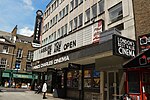Shaftesbury Theatre (1888)
1941 disestablishments in EnglandBuildings and structures in the United Kingdom destroyed during World War IICharles J. Phipps buildingsFormer buildings and structures in the City of WestminsterFormer theatres in London ... and 2 more
Theatres completed in 1888Use British English from May 2015

The Shaftesbury Theatre was a theatre in central London, England, between 1888 and 1941. It was built by John Lancaster for his wife, Ellen Wallis, a well-known Shakespearean actress. The theatre was designed by C. J. Phipps and built by Messrs. Patman and Fotheringham at a cost of £20,000 and opened with a production of As You Like It on 20 October 1888. The theatre had a stage of 28' 6" square. The capacity was 1,196. It was located on the south side of Shaftesbury Avenue, just east of Gerrard Place.
Excerpt from the Wikipedia article Shaftesbury Theatre (1888) (License: CC BY-SA 3.0, Authors, Images).Shaftesbury Theatre (1888)
Shaftesbury Avenue, City of Westminster Covent Garden
Geographical coordinates (GPS) Address Nearby Places Show on map
Geographical coordinates (GPS)
| Latitude | Longitude |
|---|---|
| N 51.5125 ° | E -0.1301 ° |
Address
One Thirty W1
Shaftesbury Avenue
WC2H 8DP City of Westminster, Covent Garden
England, United Kingdom
Open on Google Maps








